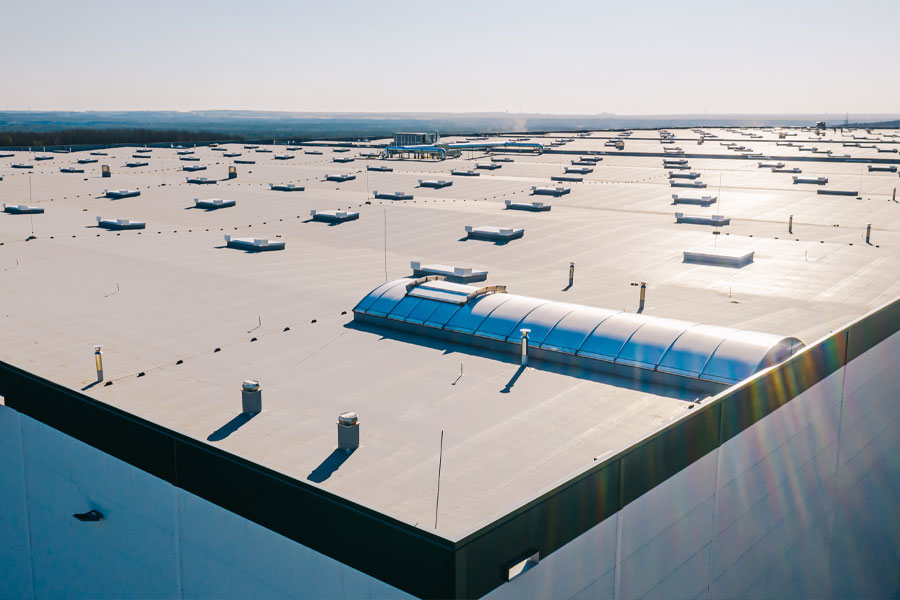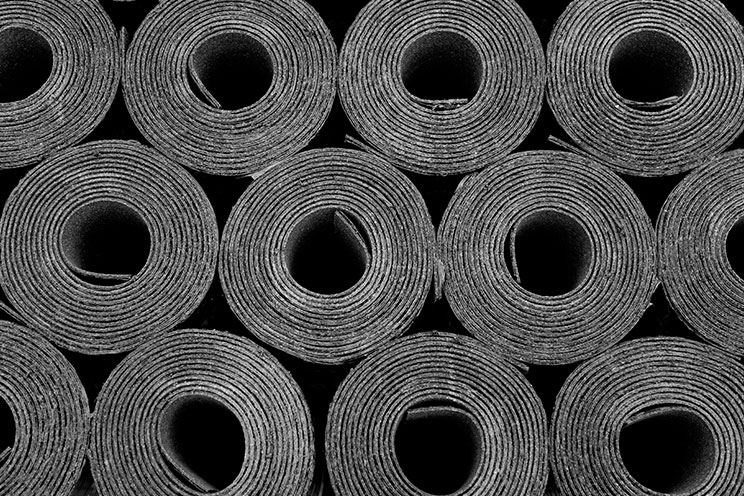
Industrial roofing tends to take a beating beyond normal wear and tear experienced by other forms of roofing. Chemicals, residues, and exhausts from manufacturing processes can break down roofing materials more quickly than natural elements.
Other factors to help determine what roof is the best fit for industrial roofing are ventilation systems and weather conditions. Industrial roofs typically have more skylights to help bring natural light to the interior of the building. Any penetration in a roofing system is prone to leaks unless the system is installed correctly and maintained.
In this post, we highlight ten of the most common types of industrial roofing.
1. Metal
The durability metal roofs are known for makes them an obvious choice for a strong defense against the elements. Improvements in the roofing industry have made metal roofs highly resistant to denting and can last up to 40 years without signs of rust.
There are multiple metal roofing types: steel, aluminum, and zinc, to name a few. In addition to metal types, metal roofing styles can be separated into two categories: exposed-fastener systems and hidden-fastener systems. Remember that metal roofs are not ideal for flat roofs but low slope roofs to ensure proper draining.
- Fire resistant
- Versatile
- Highly durable
- Wind resistant
- Durable: Strong against the elements
- Extremely Long-lasting
- Eco-friendly
- Efficiency: Save energy and money
2. Mod Bit (Modified Bitumen)
Modified Bitumen, commonly referred to as mod bit, is asphalt with modifiers added to give it plastic or rubber-like properties to make it more durable. Mod-bit is typically applied to roofs with little to no slope and can be smooth or granulated. The granules added to the roof system provide an extra layer of protection against damage from UV rays.
Mod bit roofing features unbeatable impact and tear resistance. They are known to be highly durable and last up to twenty-plus years.
- Resistant to severe weather conditions
- Highly durable
- Resistant to cracking during freezing temperatures
- Low maintenance
- Stable under heavy foot traffic
- Easily installation
- Wind resistant
- Remains structurally sound in low temperatures
3. BUR (Built-Up Roof)
BUR, known as Built-up Roof, has been around since the 1800s. BUR continues to be installed today though less common than before due to unsafe and inefficient installation practices. Even though this system is not the safest or cheapest, it is known to last 50 years or longer in some cases.
BUR is one of the toughest roofing types available today and is easily recognized for its gravelly appearance. As mentioned above, BUR is quite a costly option, but keep in mind that it is flexible in price as the number of layers can vary to help control cost or meet specific requirements that need to be addressed.
- Excellent waterproofing
- UV resistant
- Low maintenance
- Highly durable
- Low cost
4. TPO
TPO (Thermoplastic Polyolefin) is a single-ply roof membrane. TPO is manufactured in sheets that come in various sizes and thicknesses. Comprised of synthetic rubber and reinforcing scrim, this system is a newer technology with a lifespan of 10-25 years.
TPO roofing systems are only applied to flat roofs and are usually bright white to reflect the sunlight and keep the interior of the building cooler. TPO roofs are also highly resistant to fat and oils, which is an excellent choice for places that emit oils from ventilation systems.
- Highly Durable
- Fire resistant
- Wind resistant
- UV resistant
- Resistant to chemical exposure
- Puncture resistant
- Resistant to bacteria, debris, algae, and dirt
- Energy efficient
5. EPDM
EPDM (Ethylene Propylene Diene Terpolymer) is often referred to as the “original” single-ply membrane and is known to last up to 40 years. Like TPO, EPDM is manufactured in rolls of various widths and thicknesses.
EPDM is constructed from a rubbery material and has been considered a trustworthy option for years. EPDM roofing membrane has a proven track record of being a cost-effective, long-lasting, environmentally friendly option (100% recyclable).
- Fire resistant
- Cold resistant
- UV resistant
- Acid resistant
- Alcohol and solvent resistant
- Easy to install, maintain and repair
- Energy efficient
- Environmentally friendly
Recommended Reading: For a more in-depth look comparing TPO vs EPDM, click here.
6. PVC
PVC (Polyvinyl Chloride) is a synthetic plastic polymer with a life expectancy of 15-30 years. In appearance, PVC is almost identical to TPO. The most significant advantage of a PVC roof is its strength due to its hot air welded seams. While this material is costly upfront, you can save thousands in repairs and maintenance in the long run.
- Highly durable
- Resistant to chemicals
- Wind resistant
- Fire resistant
- Strength
- Long service life
- Weather resistant
- Eco-friendly
7. Spray Polyurethane Foam
Though Spray polyurethane foam (SPF) is not the most known roofing substrate, its technology has been around for over 40 years. Spray foam roofs can be used in almost any climate when adequately installed and maintained. It can also last over 50 years.
SPF starts as a liquid that turns into foam once sprayed. It expands 20 times its size in a solid form to create a seamless surface. SPF adheres to most common surfaces and can be installed on any roof slope.
- Highly durable
- Energy efficient
- Waterproof
- Easily Maintained
- Lightweight
Have an industrial roof in need of attention? Click here to find an American WeatherStar Approved Contractor in your area.
8. Roof Coating Systems
Roof coatings, or liquid-applied roofing systems, are installed directly over existing roof surfaces. Roof coating’s most common types are silicone, urethane, and acrylic. These systems cure to form a seamless, rubber-like, watertight membrane that restores and protects roof substrates.
Note that not all roof coatings are acceptable or compatible on all surfaces. Multiple types of coatings are available for industrial roofing, guaranteed to restore your roof to perfection. The formulations, uses, and application methods of coatings are all different.
- Prolongs the life of the roof
- Protects the roof from the elements
- Prevents leaks
- UV protection
- Reduces energy consumption
- Prevents roof damage
- Requires fewer repairs
- Reduces utility costs
9. Concrete
Concrete is one of the most long-lasting roofing materials on the market. As expected, concrete roofs are incredibly durable. Because of these two key factors, an increasing number of contractors are moving towards concrete roofs.
Of course, a concrete roof requires more support than other roof options. This process works best when the building consists of concrete walls and support columns. Developers have figured out how to use concrete on sloping roofs though flat roofs are significantly more manageable.
It is also worth mentioning that concrete roofs are more expensive (double or even triple the price of traditional materials). Although, it will last a lifetime and beyond with minimal maintenance.
- Impact resistant
- Fire resistant
- Low maintenance
- Extremely durable
- Long lifespan
- Energy efficient
10. Green Roofs
Green roofs are one of the most versatile kinds of industrial roofs today. The leading advantage of green roofing systems is protecting industrial buildings from the elements while also managing water, draining, and improving energy efficiency.
Green roofs are also aesthetically pleasing and are a significant step toward a more sustainable and environmentally friendly industrial building. These roofs have an average life span of 50 to 75 years or maybe even longer (not like they have been around long.)
- Help out the environment
- Improve drainage system
- Aids air quality
- Low water absorption
- Low maintenance
- Aesthetic
- Rainwater retention
Now you know that industrial roofs come in many forms, each built according to the building’s needs and budget. A property’s roof plays an essential role in the overall health of a building. Choosing a roof type can be difficult, and consulting with an Approved American WeatherStar contractor can benefit your structure’s future.
A leaking or unmanaged roof can cause damage to inventory, sensitive equipment, and other assets, not to mention the risk to the workers. If you need help choosing the best industrial roofing material or need a roofing inspection or repair, please contact an American Weatherstar representative today.
Related Posts
Modified Bitumen Roofing: The Complete Guide
Over the past 50 years, modified bitumen roofing has changed from a novel experiment to one of the most widely used commercial roofing systems.…
The 5 Most Common Types of Warehouse Roofing
From an investment standpoint, a warehouse roofing system is an invaluable asset. It protects the raw materials, manufactured goods, and other…
Commercial Roofing Systems: How They Compare
Researching commercial roofing problems and their solutions can be quite overwhelming. To help with this process, we break down some...





















